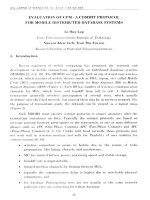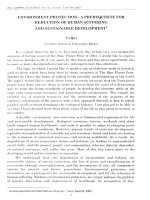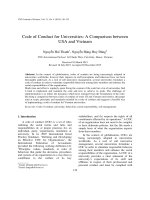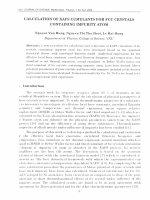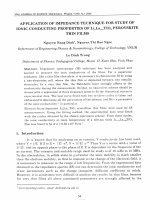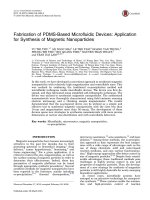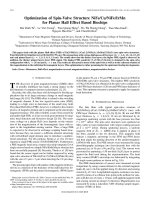DSpace at VNU: Calculation of Morse Potential for Diamond Crystals. Applification to AnhaiTnonic Effective Potential
Bạn đang xem bản rút gọn của tài liệu. Xem và tải ngay bản đầy đủ của tài liệu tại đây (3.85 MB, 7 trang )
VNL' Journal o f Scicncc, M athem atics - Physics 24 (2008) 125-131
Calculation o f Morse Potential for Diamond Crystals.
Applification to AnhaiTnonic Effective Potentia
Nguyen Van Hung*, Nguyen Cong Toan, Nguyen Bao Trung, Ngo Moang Giang
D e p a rtm e n t o f P iiysics. C o lle g e o f S cien ce. VNU, Ĩ 3 4 N íỊuycìĩ Trai, Tlianh Xiiaiì. H anoi. Victudfii
Rcccived 26 June 2008; received m revised form 15 Aimust 2008
Abstract. Analytical expressions for the M orse potential param eters o f diam ond crystals ha\'c
been derived. T h ey contain the energy o f sublimation, the com pressibility and the lattice constant.
Numerical calculations have been carried out for Si and Sn, and the results reflect fundamenlul
properties o f tliis potential. Tlic obtained Morse potential param eters have been used
for
calculation o f the anharm onic correlated cffcctivc potentials o f these cp'sials in X A I'S theory
showing clearly anharm onic efiects .
1. Introduction
Interatomic anharmonic potential, especially Morse potential, has been studied widely [1-12
The parameters o f this potential can be extracted from the XAFS {X-ray Ahsorpdon Fine Structure)
Ị 11,12J. They arc also used to calculate thcrmodynamic parameters included in these spectra f4-10|.
This potential is successfully applied to calculating the quantities involving atomic interaction,
especially, the anharmonic effects contained in XAFS [5-lOJ which influence on the physical
information taken from these specfra. They are also contained in the expressions o f equation o f state
[IJ. 'I’hcrefore, calculation o f the Morse potential is very actually desired, especially in XAFS theory.
The calculation o f Morse potential has been carried out for fee, bcc [1,22 J and hep [17,22] crystals.
The purpose o f this work is to develop a method for calculation o f Morse potential parameters
0 Ĩ Diamond, an interesting crystal structure. Analytical expressions for the parameters of this poleniial
have been derived. They contain the energy o f sublimation, the compressibility and the lattice constant
which are known already, for example see [13,18,21], The obtained results are applied to calculating
the anharmonic correlated effective potential, contained in the XAFS spectra [4-10,14], Numerical
calculations have been caưied out for volume per atom, tructural parameters and Morse potential
parameters o f Diamond crystals Si and Sn. The obtained Morse potential parameters satisfy all
fundamental properties o f this potential [19] and have been applied to calculating anharmonic
correlated effective potenlials o f these crystals in XAFS theory.
Corresponding author. E-mail: hununv@ vnu.edii.vn
125
N. V. H u n g et al. / V N V J o u rn a l o f Science, M aihem atics - Phvsics 24 (2008) Ỉ 2 5 - Ị 3Ỉ
126
2. Procedure for calculation of Morse potential of Diamond crystals
The potential energy
o f two atoms i and j separated by a distance ;-y is given in terms 0 Í'
ẹ{i-ịj)
the Morse function by
( 1)
is the
equilibrium distance o f the two atoms. Since (p{r^) = - D , D is the disociation energy.
In order to obtain the potential energy o f the whole crystal whose atoms are at rest, it IS
necessary to sum Eq. (1) over the entire crystal. This is most easily done by choosing one a t o m
in the lattice as an orgin, calculating its interaction with all the others in the crystal, and then
multiplying by N / 2 , where N IS the total atomic number m the crystal. Thus the total energy o IS
given by
^2a[rj-ro]
-a[rj-ro]
(2
Here r. is the distance from the origin to the yth atom. It is convenient to define the fo l l o w i n g
quantities
/« -+ « ; + /H '
(3)
where m ■,nJ , l j are position coordinates o f any atom in the lattice. Applying Eq, (3) to Eq. (2). the
energy can be rewritten as
/
/-«•>\I—' —2ữciAi:
\
(ĩ>[a) = L p Ỵ ^ e
- ữ(iM j
j - I L P Y jC
j
,
^ .
(4)
j
The first and second derivatives o f the energy o f Eq. (4) with respect to a are given by
^ (Ị )
IT—Ị
da
J
jC
^ +2L/ỉaỴ^M je
y
—ư(ỉA'ỉ j
■) 1Y—
I
' -2a-LpỴ^M ]e
J
2
—.ơ g M ịt
1
=
0 , and
6
r ">i
( )
J
is value o f a for which the lattice is in equilibrium, then
energy o f cohesion, [ d ^ l d a \
(5)
j
^
= Aa^L(3^YM ]e
daAt absolute zero T = 0, a
—2,ccoM :r'1
) gives the
is related to the compressibility [1J. That
IS,
(7)
where U q{cIq) is the energy o f sublimation at zero pressure and temperature, i,, c.,
d<ĩ)
V
(8 )
da
and the compressibility is given by [ 1]
1
K 00
=v„
=K
dv
(9)
dV-
w. ị\ ỉ lu n g cl a i / I'NU J o u rn a l o f Science. Mathematics - Physics 24 (2008) 125-13 Ì
where
v\.
IS
the \'olunie at T = 0, and
11
is compressibility at zero temperature and pressure. 'Fhe
v o l u m e per a t o m V = V Ị N is r e l a t e d t o t h e l at ticc c o n s t a n t a b y t h e r e l a t i o n [ 1J
( 10)
V / N = ca^ .
Subslituting Eq. (10) m Eq. (9) the compressibility
1
IS
expressed by
1
(1 1 )
Ik r
Usintỉ Eq. (5) to solve Eq. ( 8 ) we obtain
( 12)
.1
i
[■'rom Eqs. (4, 6, 7, 11) w e d e r i v e t h e r e l a t i o n
(13)
J
J
Solving the system o f Eqs. (12, 13) we obtain a , p . Substituting the obtained results into the
sccond o f Hq. (3) wc derive Tq. Using the obtained a , ( 5 and Eq, (4) to solve Eq. (7) we obtain L.
From this L and the first o f Eq. (3) we obtain D. The obtained Morse potential parameters D , a
depend on the compressibility
the energy o f sublimation ƠQ and the lattice constant a . These
values o f about all crystals are known already [13,16,18,21],
3. Application to calculation o f anharinonic correlated effective potential in XAFS
Figure 1 shows Fourier transform magnitudes of XAFS o f Sn (Diamond), measured at 77K and
300K at IIASYLAB (DESY, G ennany) [20]. They arc different at these temperatures by the shift o f
the curvcs showing anharmonic effects in XAFS. For describing these effects an anharmonic XAFS
theory is necessary.
R(A)
Fig. 1 Fourier transform m agnitudes o f X A F S o f Sn at 7 7 K and 300K.
N. V. H u n g et a l / V N U Jo u rn a l o f Science, M athem atics - Physics 24 (2008) Ỉ2 5 - Ỉ 3 1
128
The expression for the K-edge anharmonic XAFS function [10] is described by
X{k)
= F{k)
Im
( 151
kRwhere F { k ) is the real atomic backscattermg amplitude, o is net phase shift, k and /Ì arc the wave
number and the mean free path o f the p h o t o e l e c t r o n , respectively, and
(n = 1,2.3. . . . ) arc the
cumulants. The expression for the cumulants in XAFS theory is derived based on the anharmonic
correlated Einstein model [9] which is considered, at present, as “the best theoretical framework with
which the experimentalist can relate force constants to temperature dependent XAFS"' [15J. Accordinii
to this theory the effective interaction Einstein potential o f the system is given by
2 -
Here
^
M, + M ,
^ ^
is effective force constant, and
,R =
R
R
(16)
the cubic parameter giving an assymmctry in the
pair distribution function, r is bondlength and Tq is its equilibrium value. The con*elated Einstein
model may be defined as a oscillation o f a pair o f atoms with masses Ẳ /ị and M , (e.iz., absorber and
backscatterer) in a given system. Their oscillation is influenced by their neighbors mven by the last
term in the left-hand side o f Eq. (16), where the sum i IS over absorber ( / = 1 ) and backscatlcrcr
( / - 2 ), and the sum j is over all their near neighbors, excluding the absorber and backsctiercr
themselves. The latter contributions are described by the term v { x ) .
Applying the Morse potential o f Eq. (1) in the approximation for weak anharmonicity to the
X AFS theory by the expansion
V( x) = D e - 2 a x - 2e - a x
~ D ị - \ + a^x^ - a ^ x ^
X = r
(17)
so that the anhamionic effective potential Eq. (16) is fransformed as
Kff (y) = D{c,a~ + 3c^a^a)y- + c ^ D a " y \ y ^ x - a, a = (.v) ,
18)
with the effective local force constant and cubic parameter
= 2D{c^a~ + 'ic^a^aỴ k ^=c^Da^,
(19)
and structural parameters
N
c
COS^ a
(20)
J-2
4. Numerical results and discussion
To calculate the above equations to obtain the Morse potential parameters, we have to calculate
the parameter c in Eq. (10). The space lattice o f diamond is fee. The primitive basis has two identical
atoms at 0 0 0 , --------associated with each point o f the fee lattice. Thus the conventional unit cube
4 4 4
contains eight atoms, so that we obtain the value c = 1/8 for this tructure.
N .v. ỉỉii ỉ ỉ í ịe ta L / VNU Jo u r n a l o f Science, M athem aiics - Physics 24 (2008) Ỉ 2 5 - Ỉ 3 Ỉ
129
Using the theory derived in the previous section and the calculated parameter c, as well as the
energy o f sublimation, the compressibility and the lattice constant from [13,16,18,21] \vc calcLiIatcd
M orse potential parameter D, a , ỉ\ịb y our established computing programs and the results are included
in Table 1 .
Fig. 2. N earest neighbors o f absorber (A) and backscatterer (S) in X A F S o f d iam on d crystal.
Tabỉe 1. C alculated M orse potential param eters for D iam ond crystals Si and Sn
O y s ta i
D(eV)
« ( Ẳ ')
ro (Ẳ)
Si
0.9956
1.3621
2,8439
Sn
1.3189
2.0504
2,8813
Based on the coordinates o f neighbors and central atom (Fig. 2) presented in Table 2 we
Table 2. C oordinates o f neighbors o f a central atom in diam ond structure
Atom ic n um ber
X
V
z
cos(Roi.Rii)
1
-1/4
Ỉ/4
1/4
-1/4
-1/4
1/4
-1/4
1/4
-1/4
-1/4
1/4
1/4
-1/3
-1/3
-1/3
2
3
4
calculated the structural paremeters
c, = 1 + cos ^
/ 2 + c o s"ỚÍ3/ 2 + cos^ a J 2 ^ 7 / 6.
( 21 )
= -(l-í-c o s ^ ỡ r2 /4 + c o s^ a 3 /4 + cos^ớr_ị/4) = - 3 5 /3 6 .
Hence, for diamond the anharmonic coưelated effective potential from Eq. (18) is resulted as
Kf f {x) = ^ D a - x - - ^ D a ^ x ^ ,
1
KAy) =D - a
6
,
105
--— a a
36
3
(2 2 )
(23)
36
Figure 3 shows the calculated Morse potentials o f Si and Sn. They satisfy all properties o f the Morse
potential [19], 1. e., it describes repulsive force in short distance when atoms approach each other
obeying Pauli exclusion principle, and describes attractive force in long distance when atoms go far
130
N. V. H u n ^ et aỉ. / V N U Journcd o f Science. M athem aỉics - Physics 24 (200S) Ỉ 2 5 - Ỉ 3 Ỉ
from each other. The reason o f this
attraction is that ihe atoms have diffusion
moments which attract each other in lonu
distance.
Figure
4
illustrates
the
calculated anharmonic and harmonic
effective potentials for Si and Sn. They
show
strong
asymmetry
of
these
potentials due to includinc anharmonic
contributions in atomic vibrations o f these
diamond crystals.
Fig. 3. C alculated M orse potentials for Si and Sn.
Fig. 4. C alculated anharm onic and harmonic effective potentials for D iam on d
crystals Si (a) and Sn (b) showing strong anharm onic shifting.
5. Conclusions
A new procedure for calculation o f Morse potential parameters for Diamond crystals has been
developed and the obtained results are applied to calculation o f anhannonic and harmonic potential in
the XAFS theory. The derived expressions have been programed for the computation o f the considered
physical quantities.
The derived expressions for Morse potential parameters contain the energy o f sublimation, the
compressibility and the lattice constant o f Diamond crystals which are available in litcralurcs.
The good satisfying o f the calculated Morse potential with its fundamental properties, as well
as, the good description o f the effective potentials and the asymmetrv o f this potential due to
anharmonicity show the efficiency and reliability of the present procedure in computation of the
N. V- ĩỉư n g et aỉ- / VNU Jo u rn a l o f Science, M athem atics - Physics 24 (2008) Ỉ 2 5 -Ì 3 Ị
atomic interaction potential parameters as the Morse potential which arc important for calculation and
analysis of physical effccts in XAFS technique and in solving the problems involviim any type of
atomic interaction in the Diamond crystals.
Ackno^vlcd^ments; The authors thank Dao Xuan Viet and Le Day Manh for useful
conlributions to numerical calculation o f Morse potential parameters. This work IS supported in part
by the basic sciencc research program No. 4 058 06.
References
[ 1]
L.A. Gi rifalco, V. G. Weizcr, Phys. Rev. 114 ( 1 9 5 9 ) 687.
[ 2]
E. c . Marques, D.R. Sandroin, FAV. Lytic, R. B. Grccgor, J. Clieni-
Phys. 11 ( 1 9 8 2 ) 1027,
[3]
E.A. Stern, p. Livins, z . Zhan^, Phys. Rev. B 43 ( 1 9 9 ! ) 8550.
[4]
T. Mivanai^a, T. Fujikawa, / PÌÌỴS. Soc. Jpn. 63 ( 1 9 9 4 ) 1036 and 3683.
[ 5]
Ĩ . Y o k o v a m a , K. Kobayashi, T. Ohta, Phỵs. Rev- B 53 ( 1 9 9 6 ) 6111.
[ 6]
N . v . J Iung, R. Frahm, P/i\^s7C'i7 B 2 0 8 - 2 0 9 ( 1 9 9 5 ) 9 i .
[7]
N . v , Hunu, R. Frahm, H. Kamitsubo,
Phys. Soc. Jpn. 65 ( 1 9 9 6 ) 3571.
[8]
N . v . ỉ-íung, J. d e P h y siq u e IV ( 1 9 9 7 ) C2 : 279.
[9J
N . v . l i u n g J . J . Rchr , / %. v - Rev. B 56 ( 1 9 9 7 ) 43.
[10]
N . v . Hung, N. B. Due, R. Frahm, /
[11]
I.v, Pirog, 1.1. Ncdo sc ki na , l.A. Zarubin, A.T. Shuvacv, J. Phys.: Condens. M a t te r 14 ( 2 0 0 2 ) 1825,
[ 12J
l . v . Pirog, T.I. Ncd o s c k i n a , F h y sic a B 3 3 4 ( 2 0 0 3 ) 123.
[ 13J
Phys. Soc. Jpn. 7 2 ( 2 0 0 3 )
1254.
Chari. Kittcl, h U rod uciio n to S o lid -S ta ie P h ysics, John W i l ey & S o n s cd., Inc- N e w York,
Chichcstcr, Brisbane,
Toronto, Si ngapor e (1986) .
[14]
See X - r a y a b s o r p tio n , edited by D. c . Koni ngsbcrgcr and Pv. Prins (Wi l e y, N c w Y o r k , ! 988).
[15]
M. Dani el , D . M. Pease, N. Va n Hung, J.I. Budnick, Phys. Rev. B 6 9 ( 2 0 0 4 ) 134414: 1-10.
116] J.c, Slater, ỉnỉrodư cỊion to C h e m i c a l P h y s ic s (McGr aw- Hi l l B oo k Co mp a n y , inc., N e w York, 1939),
[17]
N . v . Hung, D . x . Viet, V N U J. S cien ce, M a t h e m a t ic s - P h y s i c s V o ] . 19, No. 2 ( 2 0 0 3 ) 19.
[18]
ỉ ỉ a u d b o o k o f P h y s ic a l C o n sta n ts, S y d n e y p. Clark, Jr., editor published by the soci cty, \ 09C^
[19J
Morse, P. M. , At omi c pair potential, Fhys. Rev. B. 34 ( 1 9 2 9 ) 57.
[20]
R.R. Frahm, N . v . Hu n g ( unpublished).
[21 ] J.c. Slater, ỉìUroducíion to Chemicxd Physics (McGraw-Hill Book Company, Inc., New York, 1939).
[12]
N . v . i l u n g , C o m m u n ic a tio n s in P h y s ic s Vol . 14, No. 1 ( 2 0 0 4 ) 7.

